|
|
When it looks like a silver, but isn't |
|
One thing to remember when identifying possible silver dapples: a silver mane and tail does not a silver dapple make!
Other colors can have a silvery, flaxen or gray mane and tail, and this does not
mean they are silver dilutes.
Colors most often mistaken for silver dapple are sooty palomino and flaxen liver chestnut.
Gray or silver manes and tails on red-based non-silvers are thought to be caused by the presence of the sooty gene. A Red Factor test will show such horses to be "ee" (chestnut based)
rather than "EE" or "Ee" (black based- which all silver dapples are). Testing for the silver dilution ("Z") will conclusively show if a horse is silver (if bay
or black based) or carrying silver (chestnut- based horses).
Usually these
silver mimics
can be sorted out by examining their pedigrees, even before doing color testing; they almost always have cream dilute or flaxen parentage.
Other silver look-alikes can be caused by a sabino-like mutation which can add a mixture of white
hairs into the mane and tail.
Here are a few pictures
of some Morgans who are good silver dapple mimics, but whose coloring is caused by other genes, not the silver dapple ("Z") gene.
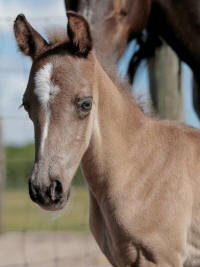 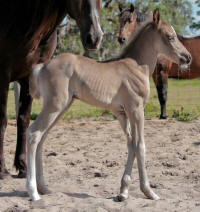
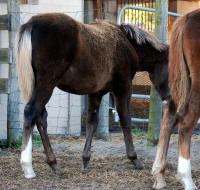 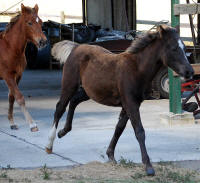
Springlake Lendon Hawke (Springlake Thistle X Dulcie Lenda), 2008 black colt
(sadly, deceased) owned by Niven Owings, Lake Wales, FL. "Lendy" was born a very pale color for a black,
complete with a light mane and tail. There are no known silver lines in his pedigree, but there IS
a lot of horses with sabino-like markings. As a weanling (bottom two photos) Lendy is more obviously black, although his tail is
still very light. However the tailhead is darkening which would be atypical of a silver. His mane has darkened considerably. How much light hair he will retain in his mane and tail as he matures
is unknown. Many horses that have their manes and tails lightened by a sabino-like
mutation tend to keep more light hair in the tail than in the mane, hence the term "silvertail" which is in common use in breeds
like the Arabian where this particular effect is more often seen than
it is in Morgans. Top two photos courtesy of Ed Okie; bottom two photos by Kristal Homoki.
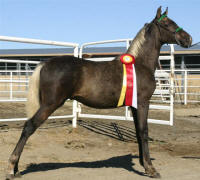
Baymount's Cisco Kid (Blacksaddle Starbuck X Baymount's Bonnie Blue), 2007 sooty/dark palomino
colt, pictured as a weanling. Cisco illustrates just how difficult it can be to sort
silver from dark palomino, visually speaking. Genetics provides the answer here. Starbuck, Cisco's sire, is a very sooty buckskin and sires a good proportion of
sooty offspring, as well. If he had a silver gene, it would show (he would be a buckskin silver). Bonnie Blue, the dam of Cisco, is a bay, so cannot
be carrying a silver gene either. After awhile you get a visual "feel" for how the very dark palomino Morgans tend to look, and can more easily distinguish them from
silvers. Photo courtesy of Jeanne Michaelis, Baymount Morgans.
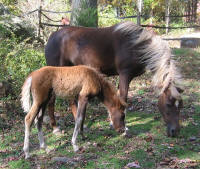
PMF Corisma (The Corsican Bay X Upland Agatha),
1988 flaxen chestnut mare, and her
2006 flaxen chestnut filly JL Lady Hawk (by Whippoorwill Red Oak). Corisma's sire is bay,
so he cannot be "hiding" silver. Corisma's dam is chestnut, but there is no
silver dapple in her bloodlines- but there
is lots of flaxen, especially through Foxfire and Tutor. If you look carefully
at the parts of her lower legs that are visible, you can see that the hair is
reddish there, typical of a chestnut rather than a silver. Photo courtesy of Corisma's owner, Mike Lodice.
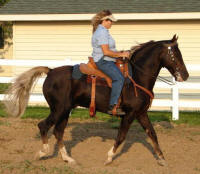 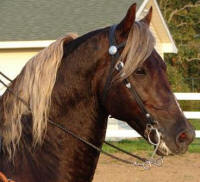
Silvershoe Colorado Moab (Mary Melís Indigo X Mile High Donsanea), 1996 flaxen chestnut stallion. The subtle reddish shading on Moab's lower legs, as well as the overall "red" cast to his coat,
taken in conjunction with the fact that
he has no silver dapple parent, indicate that he is a flaxen liver chestnut. Moab is a very good "silver
look-alike". Photos courtesy of Vali Suddarth.
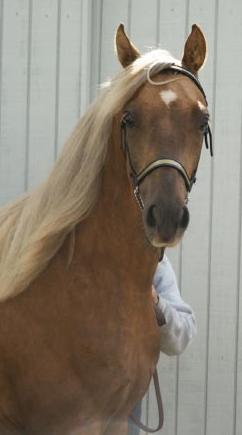
Beyond the Light (Hampshire Delight's Victory, palomino X Hylee
Redeeming Grace, chestnut), 2002 dark palomino gelding. The darker shades of palomino, like this colt, can easily
be mistaken for bay silvers. The sootiness on the bridge
of his nose adds to the effect, as many silvers have similar facial masking. Photo courtesy of Nancy Graves, Clinton MI.
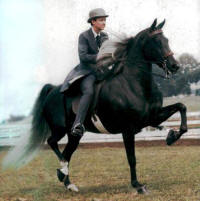
Topfield's Janet (Topfield, chestnut X Miller's Debutante, chestnut), 1969 dark chestnut mare.
With two chestnut parents it is impossible for this mare to be anything but
chestnut herself- if the parents are registered correctly as to color. A look at this mare's pedigree shows that she comes from very prolific government
bred horses; lines where silver, if present, would have been exposed in this family, primarily by two "chestnuts" producing a bay or black, or by
the eventual DNA testing of a thought-to-be-chestnut as "EE" or "Ee". Additionally, there are no lines in this mare's pedigree to the
one known silver source stallion Dan.
Other clues include the tail which is lighter at the bottom than at the top, atypical of silvers but not unusual in flaxen chestnuts (in this case, a dark flaxen chestnut with sootiness
"dirtying" the flaxen mane and tail to silvery gray). Flaxen chestnuts, often with gray or silver manes and tails, are fairly common in the old government lines.
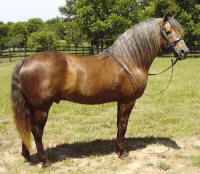 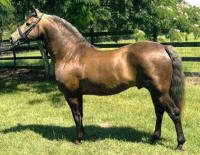
Mineral's Just In Gold (Twilight Golden Dream, palomino X Blue Knoll Crescent, seal brown),
1997 sooty palomino stallion owned by Diane Grover of Texas Dandy Morgans in Paige, TX. Justin is a typical sooty palomino Morgan; there are a lot of them out there, and a good number by his very
prolific and popular sire. For some reason, sootiness is less dorsal in aspect on chestnut based horses (which includes palominos); in other words, sootiness isn't concentrated on the topline as it is in other colors. Instead, it is heavier on the bottom part of the horse,
especially the legs. This can make the lower legs look as though they have the
darker points of a bay-based horse and in this way, such sooty palominos are often mistaken for bay silvers. The overall gold tones of the palomino are
visible through the sootiness, however. A Red Factor test has shown Justin to be "ee" (chestnut based), not "Ee" or "EE" (black based).
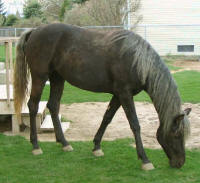 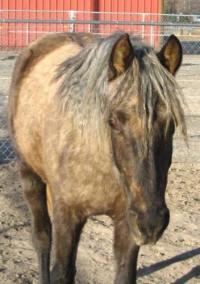
Metigoshe Mariah (Beda Acres Gold Mercedes, palomino X Metigoshe Marqessa, chestnut), 2003 sooty palomino mare owned by Darrell Charlton. Mariah
is at the darkest extreme of palomino. You might not know such horses to be palomino absent DNA testing or seeing them as foals; in Mariah's case, she was born
clearly gold and shed out to this dark color. Her sire was also a very sooty palomino. In the picture to the right, taken in her winter coat,
you can see that at certain times of the year Mariah
has
looked more obviously palomino. More photos of Mariah can be found on the Morgan Colors palomino page.
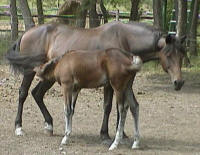
Valley Ridge Hilite's Image (Arboria Highlight, bay X CTM Whirlwin Romance, bay),
2005 bay filly bred by
Valley Ridge Morgans, Waldheim, Sask., Canada and now living in Sweden at Ice Morgans. This little gal threw me for a loop when I first saw her! She looks
very much like a silver bay or brown foal with her grayish silver mane and white tail and muted body color. Her sire and dam each have a line to known silver dapple lines; however they
are through very prolific horses where silver has not been found and/or interrupted by bays, blacks or browns. Additionally both her parents
are clearly bay as registered. Since silver is a dominant gene, one parent must be a silver (or chestnut carrying silver).
This
filly's light mane and tail are probably due
to "foal flaxen"- an extreme version of the normal light hair most foals (of any color) have in their tail and rarely, the mane as well. It will likely grow out, if so. Another possibility is
a sabino-like mutation,
which can add many light hairs to the mane and tail- and often without the horse having much in the way of leg or facial white. Eagle Quest Mozelle (Caduceus Moses, black X LSR Four Roses, chestnut
with sabino-like markings) a 2002 bay minimal sabino mare bred and owned by Elnora Schwinger,
was also born with a silvery mane and tail which grew out dark.

Back to the top
Back to the Silver Dapple Morgans Project home page.
|
|
|
|
|
|
|
|
|
|




















